flight
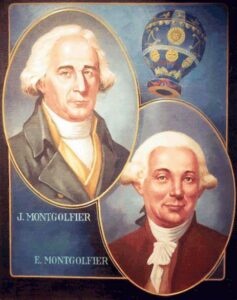 These days, we often see hot-air balloons flying over our cities in the summer. In fact, there are annual balloon festivals in many cities, and people turn out in droves to watch the colorful spectacle go up or fly over their houses. People will pay good money for a chance to take a ride in them…a chance to enjoy the freedom of floating on air for a little while and leaving all their cares far below on the ground.
These days, we often see hot-air balloons flying over our cities in the summer. In fact, there are annual balloon festivals in many cities, and people turn out in droves to watch the colorful spectacle go up or fly over their houses. People will pay good money for a chance to take a ride in them…a chance to enjoy the freedom of floating on air for a little while and leaving all their cares far below on the ground.
French physician Jean-François Pilatre de Rozier and François Laurent, the marquis d’ Arlandes, knew well, that desire. They made their dream of “floating on air” come true when, on November 21, 1783, they lifted of and almost silently floated over the city of Paris, France. Theirs was the first untethered hot-air balloon flight in history. They flew 5.5 miles over Paris in about 25 minutes. Their cloth balloon was crafted by French paper-making brothers Jacques-Étienne and Joseph-Michel Montgolfier, inventors of the world’s first successful hot-air balloons.
“Many inventors had tried to make a way to fly, building elaborate kins of wings and such, but nothing succeeded until the 1780s, that human flight became a reality. The first successful flying device may not have been a Montgolfier balloon but an “ornithopter,” a glider-like aircraft with flapping wings. According to a hazy record, the German architect Karl Friedrich Meerwein succeeded in lifting off the ground in an ornithopter in 1781. Whatever the veracity of this record, Meerwein’s flying machine never became a viable means of flight, and it was the Montgolfier brothers who first took men into the sky.” 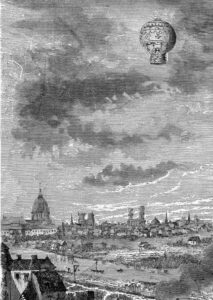
The Montgolfier brothers ran a prosperous paper business in the town of Vidalon in southern France. Because they were so successful, they had the money to finance their interest in scientific experimentation. They dabbled in several areas of experimentation, and in 1782, they discovered that combustible materials burned under a lightweight paper or fabric bag would cause the bag to rise into the air. The brothers thought it was the smoke that causes balloons to rise, when actually, it is hot air that causes balloons to rise. Nevertheless, the error in the mechanics of flight didn’t hamper their further achievements.
They gave their first public demonstration on June 4, 1783, in Annonay, sending an unmanned balloon heated by burning straw and wool, 3,000 feet into the air before it settled to the ground nearly two miles away. The brothers didn’t know that the first successful hot air balloon test had preceded theirs in 1709 and was carried out by Bartolomeu Lourenço de Gusmão, a Brazilian priest who launched a small hot-air balloon in the palace of the king of Portugal. Nevertheless, the brothers quickly outdid anything de Gusmão did.
The Montgolfiers sent a sheep, a rooster, and a duck aloft on September 19, in one of their balloons in a trial run, prior to the first manned flight. The balloon, painted azure blue and decorated with golden fleurs-de-lis, lifted up from the courtyard of the palace of Versailles in the presence of King Louis XVI. The experiment was successful, and the animals stayed afloat for eight minutes. Then, they landed safely two miles away. Finally, it 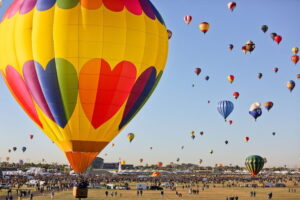 was time to try humans, so on October 15, Jean-François Pilátre de Rozier made a tethered test flight of a Montgolfier balloon. The balloon rose briefly before returning to earth. Then, finally, in a much-anticipated flight, the first untethered hot-air balloon flight occurred before a large, expectant crowd in Paris on November 21, 1783. Pilátre and d’Arlandes, an aristocrat, rose up from the grounds of royal Cháteau La Muette in the Bois de Boulogne and flew approximately five miles. Humanity had at last conquered the sky. For their achievement, the Montgolfier brothers were honored by the French Acadámie des Sciences. They went on to published books on aeronautics, and they also pursued important work in other scientific fields.
was time to try humans, so on October 15, Jean-François Pilátre de Rozier made a tethered test flight of a Montgolfier balloon. The balloon rose briefly before returning to earth. Then, finally, in a much-anticipated flight, the first untethered hot-air balloon flight occurred before a large, expectant crowd in Paris on November 21, 1783. Pilátre and d’Arlandes, an aristocrat, rose up from the grounds of royal Cháteau La Muette in the Bois de Boulogne and flew approximately five miles. Humanity had at last conquered the sky. For their achievement, the Montgolfier brothers were honored by the French Acadámie des Sciences. They went on to published books on aeronautics, and they also pursued important work in other scientific fields.
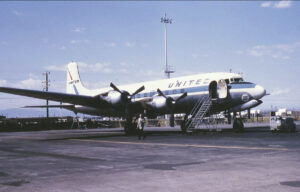 While flight remains one of the safest forms of travel, there is always the possibility of a malfunction that can have devastating effects. In the case of United Airlines Flight 624, a Douglas DC-6 airliner, registration NC37506, was a scheduled passenger flight from San Diego, California to New York City. Very likely, these passengers had taken this exact same flight a number of times, and possibly on this exact same plane. Nevertheless, this flight was about to be very different…and that difference was going to have devastating effects on the plane and on the outcome of this flight.
While flight remains one of the safest forms of travel, there is always the possibility of a malfunction that can have devastating effects. In the case of United Airlines Flight 624, a Douglas DC-6 airliner, registration NC37506, was a scheduled passenger flight from San Diego, California to New York City. Very likely, these passengers had taken this exact same flight a number of times, and possibly on this exact same plane. Nevertheless, this flight was about to be very different…and that difference was going to have devastating effects on the plane and on the outcome of this flight.
Flight 624 took off from Lindbergh Field, in what appeared to be a normal flight. The flight made its first scheduled stop at Los Angeles Airport, followed by a normal scheduled stop at Chicago Municipal Airport. Everything was normal for both stops. In fact, the  whole flight proceeded normally until they began their descent into New York’s LaGuardia Airport. They began their descent over Pennsylvania, and suddenly, they had a warning alarm telling them of a fire in the cargo hold. The crew responded to what was later determined to be a false signal of a fire in the front cargo hold by releasing CO2. Proper operating procedure called for opening the cabin pressure relief valves prior to discharging the CO2 bottles, to allow for venting of the CO2 gas buildup in the cabin and cockpit. There was no evidence found of the crew opening the relief valves. Either they forgot or it malfunctioned (which didn’t appear to be the case). As a result, the released CO2 gas seeped back into the cockpit from the front cargo hold and apparently
whole flight proceeded normally until they began their descent into New York’s LaGuardia Airport. They began their descent over Pennsylvania, and suddenly, they had a warning alarm telling them of a fire in the cargo hold. The crew responded to what was later determined to be a false signal of a fire in the front cargo hold by releasing CO2. Proper operating procedure called for opening the cabin pressure relief valves prior to discharging the CO2 bottles, to allow for venting of the CO2 gas buildup in the cabin and cockpit. There was no evidence found of the crew opening the relief valves. Either they forgot or it malfunctioned (which didn’t appear to be the case). As a result, the released CO2 gas seeped back into the cockpit from the front cargo hold and apparently 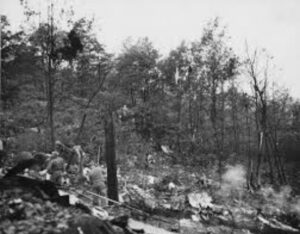 partially incapacitated the flight crew. It would be like being in a closed-up garage and leaving your car running. The decision-making process of the crew became compromised. As things got worse, the crew put the aircraft into an emergency descent, miscalculating their altitude, and as the plane descended lower than it should have, it hit a high-voltage power line and burst into flames. The plane then smashed through the trees of a wooded hillside about five miles from Mount Carmel, Pennsylvania, a small town 135 miles from Philadelphia, at 1:41pm EDT on June 17, 1948. When the four-engined, propeller-driven airplane crashed, it resulted in the deaths of all four crew members and 39 passengers on board.
partially incapacitated the flight crew. It would be like being in a closed-up garage and leaving your car running. The decision-making process of the crew became compromised. As things got worse, the crew put the aircraft into an emergency descent, miscalculating their altitude, and as the plane descended lower than it should have, it hit a high-voltage power line and burst into flames. The plane then smashed through the trees of a wooded hillside about five miles from Mount Carmel, Pennsylvania, a small town 135 miles from Philadelphia, at 1:41pm EDT on June 17, 1948. When the four-engined, propeller-driven airplane crashed, it resulted in the deaths of all four crew members and 39 passengers on board.

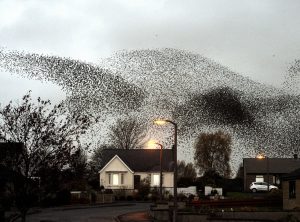 I have always loved watching birds in flight, especially when they are playing as they fly. They swoop, dive, and chase each other across the sky. We used to have pigeons downtown that played like that, but now they have moved near, or rather right over the trail I like to walk on. Since I don’t go downtown much, you can imagine how delighted I am that they have moved. Pigeons, while fun to watch truly have nothing on the Common Starling when it comes to play. The first time I saw a group of starlings in flight, I was stunned. They moved as one, swooping and diving. It looked like a cloud in the sky, but the cloud would have to be alive, which of course, it was, but not in the way you might think. The cloud was the birds, and their dance is beautiful. It was almost surreal, but it was very real.
I have always loved watching birds in flight, especially when they are playing as they fly. They swoop, dive, and chase each other across the sky. We used to have pigeons downtown that played like that, but now they have moved near, or rather right over the trail I like to walk on. Since I don’t go downtown much, you can imagine how delighted I am that they have moved. Pigeons, while fun to watch truly have nothing on the Common Starling when it comes to play. The first time I saw a group of starlings in flight, I was stunned. They moved as one, swooping and diving. It looked like a cloud in the sky, but the cloud would have to be alive, which of course, it was, but not in the way you might think. The cloud was the birds, and their dance is beautiful. It was almost surreal, but it was very real.
This group “dance” is actually called a murmuration, and it doesn’t happen every day. Starling murmurations only happen when the birds start to roost…as early as September in some places, and as late as the end of November elsewhere, with more birds joining the nightly displays during this time. Starlings usually perform their aerial acrobatics at dusk, just above their communal roosting sites before they bed down for the night. I suppose it is a joyful display, because they are preparing to have their young. That is not the only reason starlings murmurate, however. Murmuration can also be used as a defense mechanism. The idea for defense is that as a closely packed flock, can appear to it’s enemies as being much larger than any single bird could possibility appear. Grouping together in the sky does offer protection from predators like peregrine falcons, but the birds also murmurate to keep warm and exchange information on feeding sites. It’s like a natural version of social networking, I guess…with the exception of no computer.
The Starling prefers to nest in sheltered spots, away from predators, but that is not always possible. Often they 
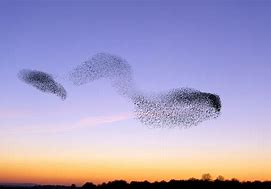 nest in “woodlands, but reedbeds, cliffs, buildings and industrial structures are also used. During the day however, they form daytime roosts at exposed places such as treetops, where the birds have good all-round visibility.” They need to be able to keep a watch to protect themselves from prey. The habits of birds has always been interesting, but the Starling is perhaps the most interesting of all the birds I’ve seen.
nest in “woodlands, but reedbeds, cliffs, buildings and industrial structures are also used. During the day however, they form daytime roosts at exposed places such as treetops, where the birds have good all-round visibility.” They need to be able to keep a watch to protect themselves from prey. The habits of birds has always been interesting, but the Starling is perhaps the most interesting of all the birds I’ve seen.
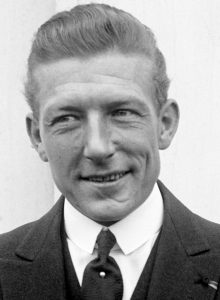
 It was a time when the race across the Atlantic Ocean was a big as the Race to Space would become years later. Since the invention of planes, everyone trained as a pilot wanted to set some sort of record in the aviation industry, and there were plenty of them out there to set. One in particular, the transatlantic flight was in its early stages. The world was waiting for that first successful transatlantic non-stop flight.
It was a time when the race across the Atlantic Ocean was a big as the Race to Space would become years later. Since the invention of planes, everyone trained as a pilot wanted to set some sort of record in the aviation industry, and there were plenty of them out there to set. One in particular, the transatlantic flight was in its early stages. The world was waiting for that first successful transatlantic non-stop flight.
Then on May 8, 1927, it looked like all that would change. That morning French aviator, Captain Charles Nungesser and his co-pilot, Francis Coli took off from Paris in a plane they called The White Bird, to the surprise of many observers who felt the weather conditions were not favorable. Nevertheless, the White Bird taxied down the runway at 5:17 am on that Sunday morning, bound for New York. The plane rose and faltered, and after rolling half a mile it finally labored into the air. As it disappeared in the distance, it was no more than 700 feet off the ground when. Less than five hours later the White Bird was sighted leaving the Irish coast on its way westward over the Atlantic. It looked as if all was going well.
The Bi-Plane was later spotted in the early morning off Nova Scotia fighting strong head winds and heading for the Maine Seaboard. It had been in the air for approximately 33 hours. Shortly after the sighting the plane mysteriously disappeared while trying to be the first to complete the non-stop transatlantic flight, flying from Paris to New York City. On the afternoon of May 9, 1927, Anson Berry, fishing in his canoe on Round Lake in eastern Maine, heard what sounded like an engine overhead, approaching from the northeast. He could not see the airplane, if that was what it was, because of a heavy overcast. He assumed that it was the White Bird, because there weren’t many planes flying in those days.
The engine sounded erratic. Moments later it stopped, and Berry heard what he described years later as a faint, 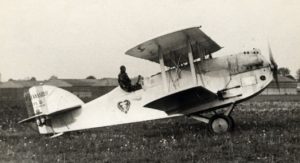 ripping crash. The afternoon was wearing on, and the always unsteady spring weather was worsening, with rain beginning to fall. Perhaps because he did not trust the weather to hold, Berry did not investigate what he heard. The plane, pilot and navigator have never been seen since and two weeks later American aviator Charles Lindbergh, flying solo, successfully crossed from New York to Paris. Many people wondered why no one had ever happened upon the wreck, but the probable area of the crash is in an area of heavy underbrush, and it is likely that the wreck has been buried in the foliage.
ripping crash. The afternoon was wearing on, and the always unsteady spring weather was worsening, with rain beginning to fall. Perhaps because he did not trust the weather to hold, Berry did not investigate what he heard. The plane, pilot and navigator have never been seen since and two weeks later American aviator Charles Lindbergh, flying solo, successfully crossed from New York to Paris. Many people wondered why no one had ever happened upon the wreck, but the probable area of the crash is in an area of heavy underbrush, and it is likely that the wreck has been buried in the foliage.
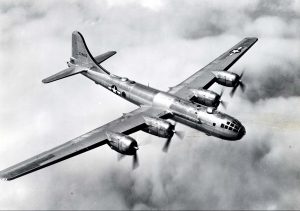 Since my dad was in the Army Air Forces in World War II, the B-17 is a plane that I have researched, watched documentaries and movies about, and toured. The B-17 was called the Flying Fortress, and my dad always said that it was a very safe plane. Nevertheless, as much as I love the B-17 Bomber, there are other war planes that were also stars of World War II. Sometimes, I think that I forget about all those others planes.
Since my dad was in the Army Air Forces in World War II, the B-17 is a plane that I have researched, watched documentaries and movies about, and toured. The B-17 was called the Flying Fortress, and my dad always said that it was a very safe plane. Nevertheless, as much as I love the B-17 Bomber, there are other war planes that were also stars of World War II. Sometimes, I think that I forget about all those others planes.
One of those planes, the B-29 Superfortress actually made its debut flight in Seattle Washington on this day, September 21, 1942. The B-29 was the largest bomber used in World War II, by any nation. The B-29 was the brain child of General Hap Arnold, back in 1939. Arnold worried that a German victory in Europe would mean the United States would have no bases on the eastern side of the Atlantic from which to counterattack. They needed a plane that could travel faster, farther, and higher than anything that was available then. Taking on the challenge, Boeing set out to create such a plane.
The plane they came up with was amazing. It could carry loads that were nearly its own weight and at altitudes  of 30,000 to 40,000 feet. The plane boasted a pilot console in the rear of the plane, capable of running the plane in the event the front pilot was knocked out of commission. It also had the first radar bombing system of any US bomber. While the Superfortress first took flight on September 21, 1942, it would not make its bombing debut until June 5, 1944, in a battle against Bangkok, as the Allies prepared to liberate Burma from the hands of the Japanese. Then a little over a week later, it was used against mainland Japan on June 14, when 60 B-29s based in Chengtu, China were used to bomb an iron and steel works factory on Honshu Island. It wasn’t exactly a successful mission, but it did boost the morale of the Americans.
of 30,000 to 40,000 feet. The plane boasted a pilot console in the rear of the plane, capable of running the plane in the event the front pilot was knocked out of commission. It also had the first radar bombing system of any US bomber. While the Superfortress first took flight on September 21, 1942, it would not make its bombing debut until June 5, 1944, in a battle against Bangkok, as the Allies prepared to liberate Burma from the hands of the Japanese. Then a little over a week later, it was used against mainland Japan on June 14, when 60 B-29s based in Chengtu, China were used to bomb an iron and steel works factory on Honshu Island. It wasn’t exactly a successful mission, but it did boost the morale of the Americans.
The United States recaptured the Marianas Islands in the South Pacific, because they were the perfect location for air bases for the new B-29s to strike mainland Japan on a consistent basis. When the bases were up and 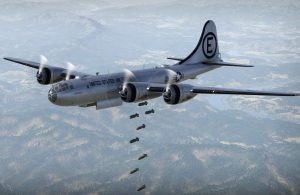 running, they were used to coordinate a series of bombing raids against Tokyo. While the B-29s were capable of precision bombing at high altitudes, they began dropping incendiary devices from a mere 5,000 feet, firebombing the Japanese capital attempting to break the will of the Axis power. One raid, in March 1945, killed more than 80,000 people. But for the Superfortress, the most famous use would happen in August. It was the only plane capable of delivering a 10,000 pound bomb…the atomic bomb. The Enola Gay took off on August 6th and the Bock’s Car took off on August 9th both from the Marianas, and flew into history. Of course, we all hope that such a bomb run would never be necessary again, but if it had been, it was good to know it was available.
running, they were used to coordinate a series of bombing raids against Tokyo. While the B-29s were capable of precision bombing at high altitudes, they began dropping incendiary devices from a mere 5,000 feet, firebombing the Japanese capital attempting to break the will of the Axis power. One raid, in March 1945, killed more than 80,000 people. But for the Superfortress, the most famous use would happen in August. It was the only plane capable of delivering a 10,000 pound bomb…the atomic bomb. The Enola Gay took off on August 6th and the Bock’s Car took off on August 9th both from the Marianas, and flew into history. Of course, we all hope that such a bomb run would never be necessary again, but if it had been, it was good to know it was available.
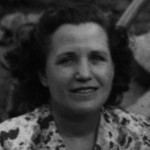
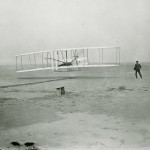 When my great aunt, Bertha Schumacher Hallgren passed way in 1984, much had changed in our world, in comparison to the world she found herself in as a young girl. To me, one of the most significant changes would have been in the area of flight…regular flight or space flight. Bertha was a very curious girl. She thought about things, and thought things through. That is the reason that she included facts of the times in her journal. I do wish she had published her works, because I think they would have been of great interest to a lot of people, even if they weren’t written about their family. The first flight took place when Bertha was just a young girl of four years, so she grew up knowing that flight was possible, but there is no indication in her writings, that she ever flew on a plane. The space program began in 1961, so she saw space flight too, and I’m quite certain that she really thought that was an amazing feat, but it did not make it into her writings either. Perhaps, by that time in her life, she thought that there just wouldn’t be much interest in her writings, aside from possibly her sister, Mina Spare’s daughter, Pauline, and later maybe her grandchildren, who were given a copy of the journal, thereby preserving this amazing book, whether accidental or not.
When my great aunt, Bertha Schumacher Hallgren passed way in 1984, much had changed in our world, in comparison to the world she found herself in as a young girl. To me, one of the most significant changes would have been in the area of flight…regular flight or space flight. Bertha was a very curious girl. She thought about things, and thought things through. That is the reason that she included facts of the times in her journal. I do wish she had published her works, because I think they would have been of great interest to a lot of people, even if they weren’t written about their family. The first flight took place when Bertha was just a young girl of four years, so she grew up knowing that flight was possible, but there is no indication in her writings, that she ever flew on a plane. The space program began in 1961, so she saw space flight too, and I’m quite certain that she really thought that was an amazing feat, but it did not make it into her writings either. Perhaps, by that time in her life, she thought that there just wouldn’t be much interest in her writings, aside from possibly her sister, Mina Spare’s daughter, Pauline, and later maybe her grandchildren, who were given a copy of the journal, thereby preserving this amazing book, whether accidental or not.
By the time Bertha passed away in 1984, she had seen the first Space Shuttle launch that took place on April 12, 1981. I have to think that she must have been very much amazed that a plane could fly into space, and return to earth again with the ability to land using its own power, to land not by dropping in the ocean, as had 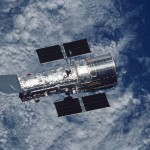
 always been the case, but rather by landing on a runway, just like a regular plane. Unfortunately, the placement of the Hubble Space Telescope came to pass just six years after Bertha’s passing, on this day, April 25, 1990. I find that particularly sad, because I think she would have loved that. I can picture her watching the news on television just to catch a glimpse of the space that surrounds our own galaxy. And I can picture her look of wonder as she thought about this amazing world of change that we live in. It was a place that always fascinated her, and I know that it did until the day she died.
always been the case, but rather by landing on a runway, just like a regular plane. Unfortunately, the placement of the Hubble Space Telescope came to pass just six years after Bertha’s passing, on this day, April 25, 1990. I find that particularly sad, because I think she would have loved that. I can picture her watching the news on television just to catch a glimpse of the space that surrounds our own galaxy. And I can picture her look of wonder as she thought about this amazing world of change that we live in. It was a place that always fascinated her, and I know that it did until the day she died.

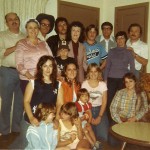 I remember getting my first camera. I was probably 6 years old at the time. Once I got it, I was almost never without it. I can’t say that I took the greatest pictures in those days, but what I can say is that I was often behind the camera rather than in the pictures. That had its good and bad points to it. The good thing was that I took pictures of the things that held an interest to me. The bad part was that often, I wasn’t in the pictures. I had never really given much thought to that until we began looking for pictures to use in the slide show for my dad’s funeral. It was hard to find some of me with my dad. I felt quite sorry about that. in the end, we found enough pictures, but I started thinking about the years ahead. I knew that I needed to do something different.
I remember getting my first camera. I was probably 6 years old at the time. Once I got it, I was almost never without it. I can’t say that I took the greatest pictures in those days, but what I can say is that I was often behind the camera rather than in the pictures. That had its good and bad points to it. The good thing was that I took pictures of the things that held an interest to me. The bad part was that often, I wasn’t in the pictures. I had never really given much thought to that until we began looking for pictures to use in the slide show for my dad’s funeral. It was hard to find some of me with my dad. I felt quite sorry about that. in the end, we found enough pictures, but I started thinking about the years ahead. I knew that I needed to do something different.
Being a photographer is a wonderful thing, and I will always love to be a photographer, but I have learned that the photographer sometimes has to relinquish the camera and be in the picture. If you never do that, it’s hard for anyone to know that you belong to the group being photographed. While that isn’t always a problem, there are times in life when it is a problem…such as the time I mentioned before. Nevertheless, in my opinion, it is great fun to be the photographer. When I see the pictures taken by other photographers, I get great ideas for shots I want to take myself. Of course, there are just pictures that happen, and no planning could make them any better than the shot you got almost by accident. Personally, I love taking wildlife pictures, with birds in flight being at the top of my list. Those are among the most difficult to take. The birds are moving so fast that by the time you get the camera ready and focused, the birds are long gone. It is a type of shot that takes lots of practice, but one that is very rewarding once you succeed.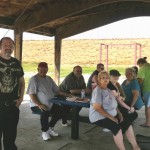
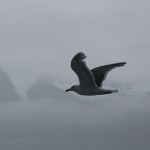
It’s strange to think that the hardest lesson for a photographer to learn can be to make sure you get in a few of the pictures yourself. You would think that would just be second nature to someone who knows the value of pictures. I’ve never felt like I am very photogenic, and maybe that is why I don’t feel such a need to be in the pictures, but after many years as an amateur photographer I realize what a folly that is. Good, bad, or ugly, I needed to be in a few of those shots.
 As a kid, I was probably…different than lots of other kids. While most of my friends were listening to rock and roll, I was too, but I also liked things that were different, like Jonathan Livingston Seagull, by Richard Bach. When Neil Diamond did his narration, I found the story line very fascinating. Here was a seagull that wanted something different from life. He didn’t want the boring everyday existence, but the extraordinary. That was how I felt. It was quite easy to relate to Jonathan’s desire for excellence and yes, even greatness. He wanted to be remembered for doing something different, and like most pioneers, he was not appreciated for his efforts. The flock was disgusted with him, and threatened to throw him out. His parents were humiliated…horrified even, that their son wanted to be so different. That could sound like lots of parents today, but thankfully not my own, who wanted their daughters to be whatever they chose to be.
As a kid, I was probably…different than lots of other kids. While most of my friends were listening to rock and roll, I was too, but I also liked things that were different, like Jonathan Livingston Seagull, by Richard Bach. When Neil Diamond did his narration, I found the story line very fascinating. Here was a seagull that wanted something different from life. He didn’t want the boring everyday existence, but the extraordinary. That was how I felt. It was quite easy to relate to Jonathan’s desire for excellence and yes, even greatness. He wanted to be remembered for doing something different, and like most pioneers, he was not appreciated for his efforts. The flock was disgusted with him, and threatened to throw him out. His parents were humiliated…horrified even, that their son wanted to be so different. That could sound like lots of parents today, but thankfully not my own, who wanted their daughters to be whatever they chose to be.
I have always loved to watch seagulls. Most of the ones I could watch…around the fast food joints in Casper, Wyoming, were of the same old boring race for food variety, but when you get out on the ocean…and watch them from a ship, it’s a very different thing indeed. Those  birds, much like Jonathan Livingston Seagull enjoy flying for the pure enjoyment of flight. I love watching them soar and glide across the sky and swoop down to glide just above the face of the water. As we sailed along, they keep the pace with the ship, almost like they are trying to stay close to the people on board. These were gulls who were doing un-gull-like things. Now, I know that none of these gulls was the famous Jonathan Livingston Seagull, but I have to think that one or two of them might be aspiring to be the next Jonathan Livingston Seagull. Maybe even a modern day Jonathan Livingston Seagull, who maybe goes by John Seagull, because those full names are so stuffy anyway.
birds, much like Jonathan Livingston Seagull enjoy flying for the pure enjoyment of flight. I love watching them soar and glide across the sky and swoop down to glide just above the face of the water. As we sailed along, they keep the pace with the ship, almost like they are trying to stay close to the people on board. These were gulls who were doing un-gull-like things. Now, I know that none of these gulls was the famous Jonathan Livingston Seagull, but I have to think that one or two of them might be aspiring to be the next Jonathan Livingston Seagull. Maybe even a modern day Jonathan Livingston Seagull, who maybe goes by John Seagull, because those full names are so stuffy anyway.
There were lots of seagulls on our trip…the kind who went out by the fishing boats hoping for scraps of food, of course. There were also the ones who hunted for their own food, gliding low over the water, and then swooping down into the water hoping to catch their prey. They even hung out around the whales, although I have no idea what they were hoping to gain by that. Perhaps they thought the whales might stir up the fish, bringing them to the surface for easier hunting. While these gulls were doing what normal gulls do…hunting for food. They were not extraordinary and they were certainly not unique.

The gulls that loved flight were something so different, however. Yes, they swooped into the water for food too, but it did not seem to be the only thing they cared about. Watching them soar across the sky, or try to keep up with the ship, holding their position so they could look into the windows at the passengers, was so interesting. You would think that the ship, or at least the passengers would scare the birds, but they seem drawn to them. It’s almost like they are showing off. Like Jonathan Livingston Seagull, they seem to be shooting for something outside the norm. And that is what draws my attention to them too.
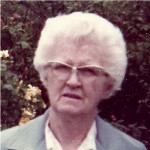 As a little girl, I remember when Aunt Gladys would come over to the house and show my mom her Avon products. Of course, with 5 girls in the house, Avon products were very important little items…whether we were allowed to wear make-up yet or not, which by the way, we weren’t yet. Nevertheless, Aunt Gladys didn’t seem to care that our curiosity would probably not bring a big purchase. She treated my sisters and me just like we were her biggest clients. Aunt Gladys knew that little girls and make-up simply go together.
As a little girl, I remember when Aunt Gladys would come over to the house and show my mom her Avon products. Of course, with 5 girls in the house, Avon products were very important little items…whether we were allowed to wear make-up yet or not, which by the way, we weren’t yet. Nevertheless, Aunt Gladys didn’t seem to care that our curiosity would probably not bring a big purchase. She treated my sisters and me just like we were her biggest clients. Aunt Gladys knew that little girls and make-up simply go together.
Aunt Gladys always looked so pretty, and she always dressed up. When she came over, it was like having a movie star show up at your door. Mom told me that she wore silk stockings, and they were very soft. She never minded when little hands wanted to see just how soft and silky they were. All she ever said, was, “Be careful not to snag them.” So many people would have wanted Mom to send the kids outside, so the adults could talk, but not Aunt Gladys, and I don’t think it was just because she was our great aunt either. I just think she understood how little girls felt about make-up and such…so much so, in fact, that she would always give us  those little sample tubes of lipstick…every time she came over. I don’t know what they cost her, but we always felt special because we got those.
those little sample tubes of lipstick…every time she came over. I don’t know what they cost her, but we always felt special because we got those.
My Aunt Gladys died in the crash of United Flight 232 in Sioux City, Iowa on July 19, 1989. She comes to my mind often, and sometimes I think I see her here in town. There is a woman here in Casper, who looks a little like my Aunt Gladys, and seeing her keeps Aunt Gladys on my mind periodically. It’s odd how that can happen sometimes…you are going through your day, and suddenly you see someone who takes you decades back in time…and you don’t even know them. They just remind you of someone else.
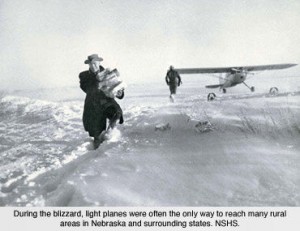
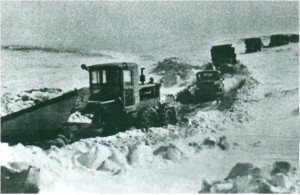 A few days ago, my father-in-law received a phone message from an old family friend. She was calling to wish my mother-in-law a belated happy birthday, and to ask my father-in-law what he remembered about the 1949 blizzard in reference to Colstrip, Montana. Since my father-in-law was in the hospital at the time, I called her back and told her that I would have him call her. Meanwhile, my own interest was peaked about this blizzard, of which I had been totally unaware prior to this call. I got on the Internet and did some searching of my own, and I was quite surprised at what I found.
A few days ago, my father-in-law received a phone message from an old family friend. She was calling to wish my mother-in-law a belated happy birthday, and to ask my father-in-law what he remembered about the 1949 blizzard in reference to Colstrip, Montana. Since my father-in-law was in the hospital at the time, I called her back and told her that I would have him call her. Meanwhile, my own interest was peaked about this blizzard, of which I had been totally unaware prior to this call. I got on the Internet and did some searching of my own, and I was quite surprised at what I found.
The 1949 blizzard began on January 2, 1949, and it was soon to be called the “worst winter ever” by anyone who had the misfortune to go through it. The storm roared across several states, and was actually a series of storms that raged on until February 22, and dumped between 50 and 60 inches of snow, depending on where you were. It put a whole lot of people, especially farmers and ranchers in dire straits. Before long everyone knew that something was going to have to be done. Emergency flights of supplies began bringing everything from food to hay to the desperate people in the area. Snow plows pushed through in an effort to get truckloads of hay into the ranchers. Still, it would not be enough to stop the massive loss of livestock that the coming spring would reveal, not to mention the 235 people across several states who lost their lives. My father-in-law told me that the cows tried to stay above the snow by walking on it as it fell. When the snow got very deep, the cows ended up walking above the trees. Then the weight of their bodies caused them to fall through the snow and into the tree tops, where the were trapped and died of starvation. Some ranchers lost entire herds of cattle, either to falling through the tree tops, or being buried alive. My father-in-law told me that the spring brought a horrible sight. Dead cattle hanging in the trees…everywhere.
Transportation came to a standstill too. Before long trains were unable to move forward, and became buried in the snow, right where they stood. When the tracks were finally cleared, the snow would stand as much as 18 feet high beside them. I’m quite sure it was an eerie sight when the trains finally began to move again, because the piled snow was much higher than the trains, and so prevented any view from the train. Not that it mattered much, because there was nothing but snow to see anyway. I can imagine that if a person was at all claustrophobic, however, the feeling that they would encounter going down that track would be almost more than they could bear.
The spring of 1949, would bring to an end, “worst winter ever” and the beginning of healing for many people. 
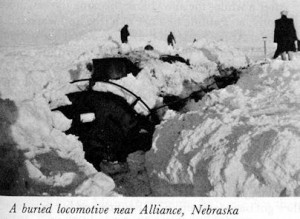 Ranchers would have to begin again. Their herds would have to be rebuilt, and it would take much time and a lot of work. I can imagine that the flooding from all that snow was devastating too. Still, healing would take place too. That spring was also one of beginnings, such as the beginning that is so special to my father-in-law, because on June 6, 1949 he would marry the love of his life, my mother-in-law, and so began their years of marriage…63 years and counting.
Ranchers would have to begin again. Their herds would have to be rebuilt, and it would take much time and a lot of work. I can imagine that the flooding from all that snow was devastating too. Still, healing would take place too. That spring was also one of beginnings, such as the beginning that is so special to my father-in-law, because on June 6, 1949 he would marry the love of his life, my mother-in-law, and so began their years of marriage…63 years and counting.

